To read accordion bass notes on a score, you need to be familiar with the bass clef. If you already know how to read the treble clef, learning the bass clef will be much easier. If you are not yet familiar with the treble clef, you may want to take a look at a lesson on how to read music notation, which will teach you the basics.

How to read the bass clef
Knowing the treble clef, you can use some simple tricks to read the bass clef:
- read notes as if they were written in the treble clef and then add two notes. For example, if in the treble clef you have an E on the first line, you will need to read it as a G in the bass clef. An A in the treble clef is a C in the bass clef; a B in the treble clef is a D in the bass clef and so on.

Or instead of adding notes,
- You can simply read the bass clef notes as if they were one step higher, so if you see a note on the first line, imagine it is on the second line and read it as you would if you were reading the treble clef. The same goes for a note placed in a space on the staff: for example, if you see a note on the second space, it is equivalent to a note on the third space of a treble clef staff.

Notation written for Stradella bass
There are 3 kinds of bass notes on the accordion:
- Bass
- Counter-bass
- Chords
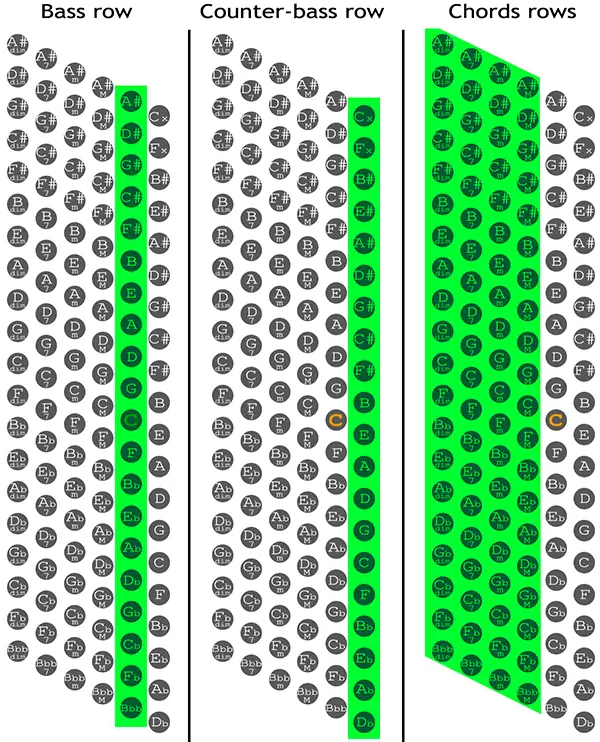
Counter-bass notes are on the 1st row.
Chords are on the 3rd, 4th, 5th, and 6th row.
Position on the staff
Bass and counter-bass are in a lower position on the staff than accordion bass-chords. On accordion scores, usually, in the lower position, you’ll find a D and in the highest, a C.
Take a look at the staff below.
Bass & Counter bass:
Chords:
Accordion bass notation
The standard accordion bass notation is quite simple as basses, counter basses, and chords are all represented with a single note on the staff.
There are four different kinds of chords on the accordion: major, minor, seventh, and diminished. You will find a letter, a number, or an abbreviation near a chord note that defines the nature of the chord:
- “M” = major
- “m” = minor
- “7” = dominant 7th and
- “dim” = diminished 7th chords
On scores written for Stradella bass, the lower note is a bass and the higher note is a chord.
As you can see in the example below, the notation for major, minor, 7th, and diminished chords is always the same: there’re two C notes, an octave apart.
The lower is a C bass and the higher is a C chord:
C Major:
C minor:
C Dominant 7th:
C Diminished:
(Fingering for major chords is 4-3, for minor, 7th and diminished is 4-2 )
Rhythmic patterns on the Stradella Bass System
The Stradella bass system was designed to play traditional and popular classical pieces, waltzes, mazurkas, polkas, marches, etc. The most common rhythmic patterns are in 4/4, in 3/4, in 2/4 (which it can be written in 4/4 as well) and in 6/8.
There’re many other common time signatures but let’s focus just on:
4/4 (marches, ballads, fox-trot, and polkas for example)
and
3/4 (waltzes, mazurkas, minuets, and dances)
Left hand notation: different styles
Here you can see the same melody written for accordion, for piano, and for any other instruments (“Just chords”).
A simple melody in 4/4:

The first line of the score shows the accordion notation, where chords are written as a single note on the bass staff. This is a common way of writing chords for accordions, as it allows the player to easily see the root note and the chord type.
The second line of the score presents a piano notation, where chords are written as groups of notes on the bass staff. This allows for more detail and the ability to play inversions of the chords. On a piano, you can choose to play different inversions of the same chord or you can play a bass note at a lower octave; on the accordion, there is only one octave for basses and chords cannot be changed. It’s not possible to play chord inversions on a standard bass accordion. This is why accordion notation is less detailed than piano notation.
The third line of the score is a bit different, as the bass staff is left blank and the chords are written as names only. Once you know how to arrange a rhythmic pattern, all you need in order to play an accompaniment for a melody is to know the chord progression. Jazz and pop music, for example, are usually written on a single staff with chord symbols. In my opinion, it’s important to learn how to play as many different styles of accompaniments as possible because sometimes the score doesn’t give you any information about it.
The same melody in 3/4:
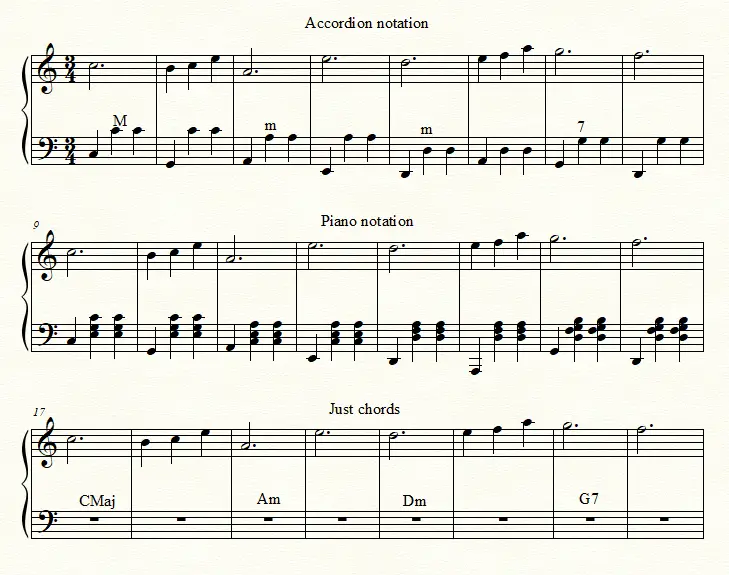
In this example, there are 4 chords: C Maj, A min, D min, and G 7th.
Regardless of the time signature, you can see how bass notes follow the same pattern:
(C – G), (A – E), (D – A), (G – D)
These are all fifth intervals and in fact, accordion basses are arranged in a circle of fifths. This means that you can alternate roots and 5ths very easily on the accordion and therefore it is very easy to play all those rhythmic patterns in which there is this alternation of bass.
Tip: One way to start reading different types of scores is to play children’s rhymes. Since you probably already know the melodies of these songs, it will be easier to follow the score, even if it is written for piano or if it only has chord names. A great resource for finding children’s rhyme scores is WeLoveRhymes.com. This website collects children’s rhymes and provides a downloadable PDF score for each song. Plus, the scores on this website are all different, so it can be a great exercise to get used to the different notation styles of the bass staff.
Accordion counter bass notation
Accordion counter bass notes are often underlined with a little dash so you can distinguish them from bass notes.

Accordion bass chords combination
A combined chord is a chord that combines a root note (bass or counter bass) and one or two chords (major, minor, 7th, or diminished) from a different root line to play an extended chord.
For example, D minor 7th (Dm7) combine a D bass note and an F major chord, let’s explain why:
Minor 7th chords are minor chords with a dominant 7th. On accordion, there’re “minor” and “7th” chords but no single button for “minor 7th” chords. To play a minor 7th chord on accordion you need to play the root and the other three notes which complete it.
- D minor (Dm) is a triad consisting of the pitches D (root), F (minor third), and A (fifth).
- D minor 7th (Dm7) is a quadriad consisting of the pitches D (root), F (minor third), A (fifth), and C (minor seventh).
Probably your first thought is to add a C to the D minor chord but this is not the solution since if you add a bass C note, it sounds as if C were the root of the chord created (something like C, D, F, A).
The right solution is to use D as root, then adding the notes that complete the Dm7 chord: D + F, A, C.
Which chord plays these notes all together? The answer is: F major chord.
So, to play a Dm7 on accordion bass you need to push the D on the bass or on the counter bass row and the F major.
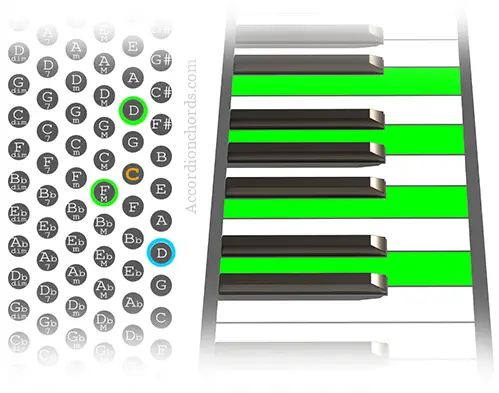
Combined bass chords notation
Notation for combined accordion bass chords follow the same rules explained before:
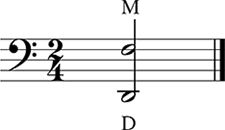
The lower note is a D, this means that D is the root and the higher note (F) is a chord. The letter “M” indicates that the F chord is major. Although this is a correct way of representing the Dm7 chord, you are more likely to find the chord name, as combined chords are used in musical genres that usually don’t use double staff.

For this reason, it’s important to learn chords as patterns in order to play complex chords on accordion bass.
Accordion bass scales
Since the first two bass rows are single notes, it’s possible to play scales with the left hand. In the example below you can see the D major scale:

There’re many scales with different fingering but I’ll talk about other kinds of scales in another post. As you can see, bass and counter bass notes are combined in a specific sequence with a specific fingering. The dashes and fingering numbers help to find which button you need to play in sequence.
Author: Giovanni Lucifero
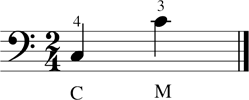
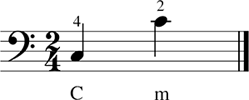

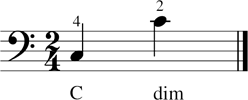


Thanks!
Di nulla! 🙂
I’m just considering playing the piano accordion after many years playing the piano and organ using notation.
Using chords makes things incredible more complicated first of all you have to remember all of the available chords and their combinations with notation once you’ve learn the notes and their positions on the scale you just read it, no remembering of note combinations either.
I appreciate what you say on this web site that some music will have the chords written on the G clef either above or below the staves and not in notation, which in my opinion is just laziness or the person who wrote doesn’t understand notation fully, after all classical musicians wouldn’t have chords on there musical scores.
What would be useful for me it to see all the button positions on the bass scale do you have such a thing on this site? I’m working my way through this site to determine if I could play the accordion and It’s been very useful in helping me decide which accordion I would be best suited to. I can see you have put a tremendous amount of work into this site which I and many others must appreciate many thanks.
Hi Stephen,
I understand your point of view but you should consider some other aspects: the left hand on a Stradella bass system does not work as it does on a piano or organ. On a piano, you have to build chords and you can do it in many different ways; on the left side of the accordion, you can play all major, minor, seventh, and diminished chords just by pressing a button but there are no options, the chords are as they are, you can’t use different inversions or voices like on a piano. The layout of the Stradella system has been designed to facilitate accompaniment which uses alternating bass and chords in a rhythm pattern so if you know the chord sequence of a song, you can play without needing any other information from the score.
Combining the chords of the Stradella system to build more complex chords might be intimidating but it’s just a matter of getting used to those new positions.
There is nothing wrong with playing by reading sheet music, you can just play the left-hand notes that the sheet music says to play, but you should also know which chords you are playing to get a deeper understanding of chord progressions and the harmony. Reading without analyzing the chord structure will make you “addicted” to the score and it’s something that I suggest avoiding.
Some musical genres don’t need the double staff like in classical music. Think for example to a score from “The Real Book”: there’s the melody and the chords sequence, that’s it. This happens not because of laziness or ignorance but because you can play a jazz standard in an infinite variety of ways. Jazz music is more “free” than classical music so there’s no indication about how to arrange the accompaniment, there’re just chords symbols, you can choose how to play it. Obviously, it’s more difficult than reading what you have to play, you have to know how to build an accompaniment just from the chord sequence but it’s funny and challenging.
About showing the bass position on the bass scale: there’s just one octave on standard-bass-accordion so the complete scale is the same you can see in this article in the “Position on the staff” paragraph. Sometimes the lowest note is a C instead of a D as reported on my scale. All other buttons except the first 2 rows (basses and counter basses), are all chords and they are written as single notes at a higher octave. That’s it.
The best thing you can do in order to choose what kind of an accordion to buy is to meet an accordion teacher so you could try to play his accordion and receive all information you need. Buying the first accordion without some help is pretty hard.
Thank you so much for your appreciation 🙂
Let me know if I’ve answered your questions!
Yes the more I read your web site, the more I’m beginning to understand. It’s seems the accordion was developed more for chords than for notation . I’m 63 now and have read notation since 12 years old in that time none of my tutors would ever discuss chord patterns it just taboo. All my sheet music that I use is notation only . The problem with chords patterns it doesn’t show you the length of note or rhythm. For instance a C major chord pattern in 4/4 bar would indicated you held the chord patterned for 4 beats ,how would you write it for 4 crotchet beats, would you write the chord pattern 4 times to indicate 4 beats , what if the notes were 8ths or worse case 32nds?
I’m still working my way through your web site and I’ll probably have a better understanding when I reach the end of it. It’s a great site and I’m learning so much the transition to chords will probably be a big issue for me.
Many thanks for your response.
Hi Stephen,
I’m glad to help! 🙂
I’ve added this paragraph: The Stradella bass system
Take a look, I’ve created some scores to show you what I mean. Let me know if it helps.
The accordion, like the piano, is a “3 in 1” instrument: it plays the melody, it plays a bass line and it plays chords. If you play the saxophone, for example, you can play just one note at a time, this means that you need to play the melody along with a bass player who plays the bass line and a guitar player who plays chords to get all 3 parts together.
When we talk about the left hand, Stradella bass has fewer options than a piano but it makes it easy to play simple accompaniments that alternate bass and chords.
Usually, accordion accompaniment patterns are simple, one basic accompaniment is the “alternating bass” which can be used in different time signatures and on many different rhythm styles.
The accordion is a great instrument to learn harmony so don’t hesitate! I’m sure that you will be happy to get a deeper understanding of the music you play.
Take a look at this tutorial when you have time.
Thank you!
Thank you very much for those examples, I understand them all. Looks like I’m going to have to make the transition to chords for the bass.
Many thanks again, I going through your website as I write.
If you have any other questions, don’t hesitate, I’m happy to help!
Thank you, Stephen!
As it happens I learnt to play the alto sax many years ago but concentrate mainly on the piano now.
Me too 🙂
I’ve also studied piano, just popular classical pieces.
Now, I can’t play a single tune, too many months without touching the piano, I’ve lost muscle memory.
Hi Giovanni
I can’t grasp the difference between the fundamental and the counter bass buttons, do you have an explanation of the difference?
The accordion has 2 columns of single bass notes: basses and counter basses. Both columns, share the same reeds so there’s no difference except the position.
Basses are on the second column and counter basses are on the first one. Both follow the circle of 5th.
The “fundamental” (also known as “root”) is the note that gives the name to the chord, for example, C is the fundamental of CMaj7. Both basses and counter basses can be fundamentals.
Giovanni
I’m finding that the music you wrote is helping me find the chords on the bass clef like E7 and others as it’s not so easy at the moment working out which chord is where, sure I can read the notation but I trying to find the chord positions if you understand what I mean.
I’m told the best accordions are made by the Italians ,is that true?
I’m not sure I’m understanding what you mean but I assume you are talking about building the muscle memory that will allow you to find quickly all chords position you need.
If this is the case, just keep practicing. It’s just a matter of getting used.
About Italian accordions: yes 🙂
Just had to refer to my music theory book, I couldn’t remember the X incidental. I don’t come across it very often in my sheet music. I’ve enjoyed the accordion music that you have on Y Tube.
Thank you Stephen!
The double sharp is quite rare but let me explain why there’s some “x” on the accordion.
From bottom to top, the bass buttons of the accordion are ordered by intervals of 5ths, in other words, they follow the circle of the 5ths.
For example, starting from C, you find G, D, A, E, B. If you keep adding a 5th you get F#, C#, G#, D#, A#, and now what’s the next note? If the 5th of A is E, then the fifth of A# is E#.
Let’s add another 5th to E#: if the 5th of E is B, then the 5th of E# is B#.
Now, let’s find the next note: if the 5th of B is F#, then the 5th of B# will be Fx.
Add a 5th to Fx and you have a Cx because the 5th of Fx (which is a G) is Cx (which is a D).
Thanks again for all your responses, especially about the counter basses as I was having a little problem trying to find a decent explanation on the internet. I did notice the X buttons now I know too.
Glad to help!
Thanks! 🙂
Hi I am supposed to play a C tune in g then I am supposed to change my left hand to match but I find it hard to use the three notes position in three different places were to hold my fingers
Hi Annelise,
I’m sorry but I don’t understand your statement…what is the “three notes position in three different places” you’re talking about?
To get to know the geography of the bass notes you can use scales to practise for the bass and counter base buttons, but what can you do to learn the geography of the chords? Is there a technique to practise to get to know their geography? Or is it once to get to know the layout of the bass notes you just move along the rows.
Hi Stephen,
you are correct in your last statement that the relationship between the chord buttons and bass buttons is essential to understanding the layout of the Stradella system. Once you become familiar with the pattern of the bass notes, you can apply the same pattern to the chord buttons. For example, the same pattern of C, G, D, A, E, etc. in the bass buttons corresponds to CMaj, GMaj, DMaj, and so on in the chord buttons. Similarly, the pattern of Cm, Gm, Dm, etc. Same thing for all other chords.
thank you very much for your bass noes it has solved a problem as i am used to playing the melody on the accordion and i have been trying to pair the bass and melody off i have been using the fundamental bass and trying to combine a melody and bass.
Hi Brian,
Thank you for your comment! I’m glad to hear that the information on bass notes has been helpful. Combining bass and melody can be tricky, but it sounds like you’re on the right track.
Keep experimenting with the fundamental bass, and you’ll continue to improve.
Thanks again, and happy playing!
Best
Giovanni